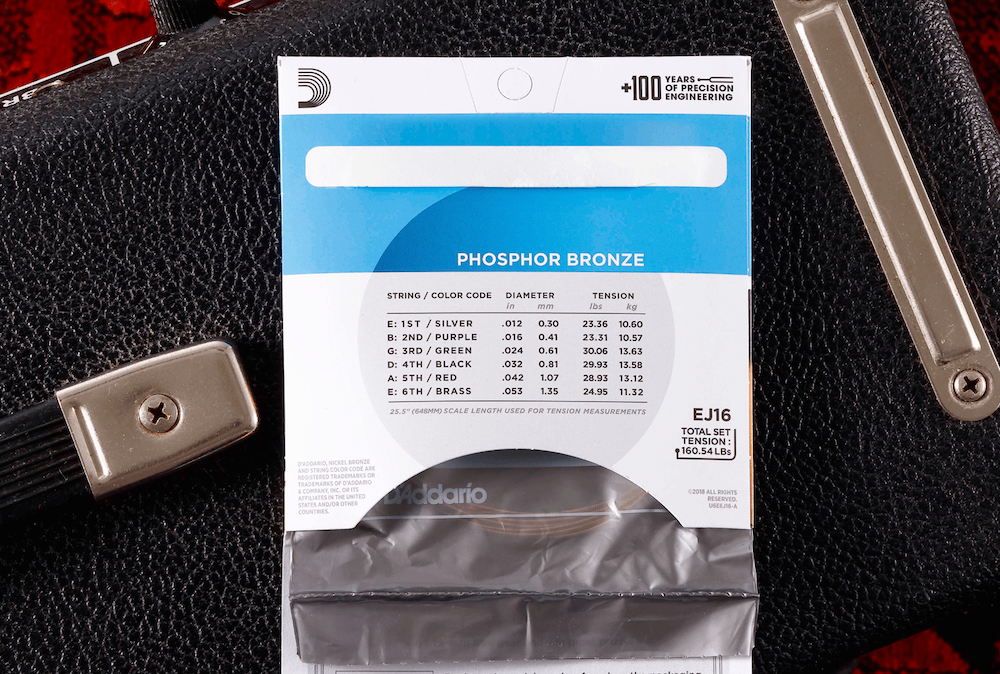Learning to play the acoustic guitar is a very rewarding endeavor. Like other worthwhile learning experiences, it can have its challenging moments — but picking out strings doesn't have to be one of them.
Picking out strings is like choosing the color of your shirt – you go with what you like. There is no wrong answer.
D'Addario doesn't make bad strings, therefore you cannot make a bad string choice. You only need to experiment a bit to find which strings best suit you.
There are just two simple things to consider in choosing strings — what they're made from and their thickness i.e. material and gauge.
MATERIAL
What a string is made from is the defining element of its tone, especially on an acoustic. With an acoustic guitar, it's only the strings' natural beauty coming through. While at first, it's not easy to detet the subtle sonic differences between string materials, with a little time, you should be able to understand how these descriptions translate to real sound.

PHOSPHOR BRONZE
Invented by D'Addario, Phosphor Bronze strings offer the ideal combination of warm, rich bass tone, balanced with clear treble tone. This is the most popular acoustic string alloy, ideal for all guitars and playing styles.
80/20 BRONZE
80/20 Bronze strings deliver a deep bass response, sparkling, bright overtones, and maximum volume. They are a vintage guitar tradition.
Both of these string types come with the option of being coated. Coated strings last three to four times longer than traditional strings, while maintaining the string's natural tonal qualities. So, if you don't like changing strings that often, get yourself some coated acoustic guitar strings, like XT or XS.
GAUGE
Strings are organized by thickness. In string world, thickness equals "gauge." We're talking small numbers here, so you likely won't be able to detect the difference in gauge with your eyes, but with some experience, you can probably feel it — and hear it.

String gauges are measured in 1/1000ths of an inch. For simplicity, we list two-digit numbers to represent this, namely the thinnest string (High E) and the thickest (Low E) i.e. 10–47. Besides having a name like "Custom Light," string sets are also referred to by their highest/thinnest string number i.e. "10s." Though not always necessary to know, the other strings will have their gauges listed on the packaging if you're interested.
When you're learning, it's a good idea to start out with light gauge strings first. Lighter strings will be easier on your fingertips, so you can avoid blisters. They also can be pressed down and bent with less resistance, which is helpful when you are still strengthening your hands.
Start with a lighter string set like Extra Light (10–47), Custom Light (11–52), or Light (12–53). They will be easier to play. The only drawback is that they produce less volume and slightly less powerful tone. However, when your professional music career is in its infancy, you can sacrifice a little sound projection for an easier playing experience. And to be clear, there is nothing wrong with light strings. Some experienced acoustic players will stick with them for life.
Once you've got some practice in, you might want to try a heavier string. Medium strings (13–56) are your next option. They'll add a bit more body to your sound, as you sacrifice a little bit of playability. Lastly, perhaps you'll even go on to the rare and feared — heavy gauge! Just kidding about the "feared" part, but those 14–59 heavies are definitely going to be harder to maneuver your fingers across. Could it be worth it? I guess you'll find out. It all depends on what you like and how you play. Give them all a shot and see what works for you!






